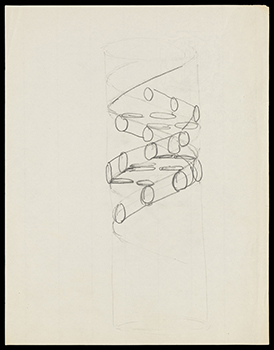An international symposium and exhibition
Submission deadline: May 5, 2015
Opening: June 24, 2015
BAK, basis voor actuele kunst
Utrecht
The Netherlands
[email protected]
www.mahku.nl
www.bak-utrecht.nl
“Thought is impossible without an image.”
–Aristotle, On Memory and Reminiscence (450a)
A Call for Drawings is selecting drawings from artists, scientists and other professionals for an interdisciplinary research project investigating the role of visual thinking and the role of visualizations in cognitive and creative processes. It is a procedure analogous to the practice in the academic world of “a call for papers” in preparation for a symposium or conference at which research is to be presented and information shared.
In scientific and technological disciplines (and others, notably architecture and design), sketches, maps, drafts, diagrams and other kinds of drawings are essential to the understanding of problems and the communication of thoughts towards their solutions.
When probing into the unknown, drawing is an ideal tool because drawing is thinking, pointing; it makes things present and puts them at a distance, it is a mode of inquiry. Drawing can represent the seen and present the unseen, the known and the unknown.
Mel Gooding states: “There is very little in our material culture that is not drawn first and nothing understood in the natural world without the attention of drawing being paid to it. Every drawing is a kind of proposition of what is possible. Drawing, complicit with the act of looking, informs the eye’ s perception, reflects the world into the seeing mind. Drawing, complicit with the act of thinking, informs the mind’s conception, refracts the thought into the comprehending world.”
In his book Insights of Genius, Arthur I. Miller explores how “visual imagery plays a causal role in scientific creativity;howit is usually essential for scientific advance; and visual imagery generated by scientific theories can carry truth value.”
University libraries testify to this in the value they place on their magnificent collections of scientific drawings.
In order to understand certain kinds of problems one has to make them visible. Fine examples of this are the drawings and the sculptural model created by Watson and Crick in their research to discover and demonstrate the structure of the DNA, following on from such two-dimensional imagery as Rosalind Franklin’s X-ray diffraction data. Such visualizations, using media usually associated with artistic practices such as drawing, photography and sculpture, were indispensable to their insights and the presentation of their discovery.
A Call for Drawings is a project initiated and organised by Klaas Hoek. He is core-tutor at MaHKU MA Fine Art, HKU University of the Arts Utrecht and lecturer, Head of Print at Slade School of Fine Art, UCL London.
Submitting your drawings
If artists, scientists and other specialists demonstrate and share drawing methodologies we might establish a common ground between diverse disciplines, and discover correspondences between the creative processes in different fields of activity; we could maybe share knowledge and collaborate on more fundamental levels in the production and communication of new knowledge.
We invite scientists, artists, architects, musicians, football coaches, carpenters, chefs, and other professionals to send in two drawings:
A. The first submission should be the first drawing made to try to understand a problem and possibly as a solution. It can be the visual representation that pops into one’s head after a great deal of conscious work on a problem. It will be captioned to indicate the specific nature of the problem.
B. The second submission should be a drawing made to show the problem to another person. It will be captioned to indicate the direction or import of what is discovered.
To take part in the selections send your drawings with a CV/biography via e-mail to [email protected].
Presentations
First exhibition
BAK, basis voor actuele kunst
Utrecht, the Netherlands
Opening and symposium: June 24–July 12, 2015
Second exhibition
London, UK: autumn 2015
A Call for Drawings was launched at KNAW, The Royal Dutch Academy of Sciences on February 2, 2015. More information from the Royal Dutch Academy of Sciences/ Society of Arts, AVK/KNAW can be found here.
This project is made possible with the support of KNAW/AVK Amsterdam; MaHKU Fine Art, Utrecht; HKU University of the Arts, Utrecht; BAK, basis voor actuele kunst, Utrecht; and Slade School of Fine Arts, UCL London.
